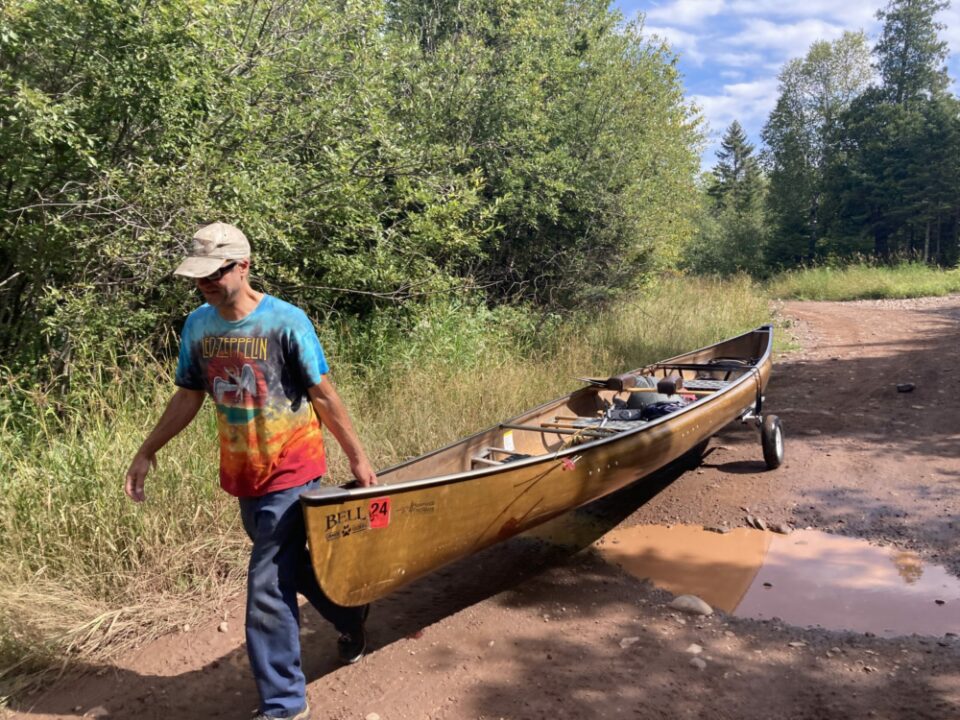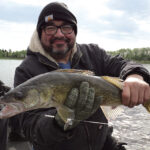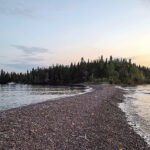Everyone loves the pain and suffering of portaging a heavy canoe on their shoulders, right? It’s part of the voyageur mystique of canoe camping. When you carry your boat through a rocky, root-filled portage, with endless climbs and steep descents, you’ve essentially earned your badge of honor as a canoeist.
But just hypothetically speaking, have you ever wondered if there are any alternative methods to get your canoe to those hard-to-reach lakes? Maybe you’re eyeing the map, wishing you could access some lakes tucked far in from the nearest parking area… But how would you ever make it out there? And if you’re like me, how would you get all your endless fishing tackle (camping gear, whatever you like to bring) out there too? Tired of double (and triple) portaging with my large family, I decided to take the plunge, and give portage wheels a shot.
Immediate disclaimer—portage wheels are forbidden in most of the Boundary Waters Canoe Area Wilderness (they are still considered “mechanized” by the Superior National Forest). And I get it—modern wheeled carts are a violation of the heritage and canoeing culture that is so important to the BWCAW. I will never give up portaging a canoe on my back when in this holy place.
Let me also mention, I used to view portage wheels as “cheating.” You’re not going to win any purist points with portage wheels. Was I going to be a “traitor?”
Still, I was determined to see if portage wheels could expand my range. That was the benefit I sought—how to go to places that I just wouldn’t get to otherwise. Specifically, I had two fishing lakes in mind in Tettegouche State Park that have ATV trails or access roads leading to them, but which don’t allow cars. Both lakes are over a mile and a half in from any parking area. I hypothesized that these lakes are rarely fished.
I sprung for the 16-inch wheel portage cart made by Spring Creek Manufacturing in Mountain Iron, Minn. Here’s how it works: First, you place the back end of your canoe right-side-up between two “bunks” attached to a raised aluminum axle bar. You want the bar to be about a third of the way from the back of your canoe. Tighten the two tie-down straps, which hold the canoe firm to the cart. Then, tow the boat by pulling from the front handle of the canoe. The tires will roll forward and you’re heading to the lake.
The transformations are many.
For one, the canoe now becomes your pack: fill it with everything you need for your trip. Life jackets, paddles, fishing rods, tackle boxes, lunches, packs… the proverbial kitchen sink can go directly in the upright canoe as you pull it. No more snagging fishing rods in tree branches, tripping on loose life jacket straps, or dropping loose items, never to be found again.

Transformation two: you can actually see where you’re going. You no longer have a huge roof (canoe) over your head as you walk through the beautiful forest. Everything is instantly more visible. This makes for easier, safer navigation.
Transformation three: you can actually hold a conversation while you portage. The wheels are a beneficial tool on “roads” (often not open to car traffic) where two people can walk side by side. It’s a nice change of pace to hold a conversation with your buddy or partner as you head into the wilderness.
So, what about the “cheating” aspect? Can you live with yourself after this?
“I didn’t feel like it was cheating at all. It’s a non-motorized, muscle-driven way to get into a remote lake,” says Jeff Hall, a fellow fisherman and previous wilderness canoe guide.
Hall points out that only the final third of the canoe is actually transported by the wheels.
“Just because you have wheels doesn’t mean the work is done for you—it’s only one axle, and you still have to ‘carry’ the front part of the canoe,” he says.
Hall says that portage wheels won’t work everywhere—if the trail is too rocky, or too narrow, you’re better off carrying the canoe on your back. Hall considers the wheels just another option in the canoeist’s arsenal.
“Any way to get a canoe in that’s non-motorized, whether it’s wheels or on your shoulders—that’s where it’s at. There’s no right or wrong. It’s a win-win.”
Hall also warns of the trouble that would ensue if you popped a tire in the wilderness with all the individual items stashed in the canoe. Still, he says the risk is worth it.
“It’s nice to have the wheels, because then you can throw everything in the canoe and use it as a pack on a portage, as well as a canoe on the lake. You can throw everything in and haul it.”
Portage wheels serve a particular purpose very well; they are an alternative method to get you (and all the loose gear you bring) into lakes previously considered the realm of snowmobilers and ATVers only. Portage wheels break down barriers. All of a sudden there are a lot more lakes on the map that fit the “can’t-carry, but will-pull” description. I’m hungry for more.





